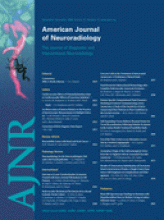We read with interest the article by Kaufmann et al1 about the cardiovascular effects of polymethylmethacrylate (PMMA) injection during percutaneous vertebroplasty (PV).
The authors compared patients’ vital signs before with those during and after PMMA injection: no significant differences were noted between preinjection mean arterial pressure (MAP) and that during, 5 minutes after, and 10 minutes after PMMA injection. The authors concluded that there were no clinically relevant generalized systemic cardiovascular effects related to PMMA injection during PV.
We retrospectively reviewed charts of 33 consecutive patients who underwent 48 PVs at our institution: systolic and diastolic blood pressure, heart rate (HR), and systemic arterial oxygen saturation were recorded from before, during, 10 minutes after, and 20 minutes after PMMA injection. Conscious sedation was administered by an experienced interventionalist (G.D.B.) and titrated for effect.
Our results differ substantially from those reported by Kaufmann and colleagues: a significant difference was noted between preinjection MAP and MAP during, 10 minutes after, and 20 minutes after PMMA injection using the paired Student t test (P = .04, 0.03, 0.02). On the other hand, no significant differences were noted between MAP during PMMA injection and MAP 10 and 20 minutes after PMMA injection.
We hypothesize a role for the routinely administered sedatives and narcotics (meperidine and midazolam), whose effects (in particular for meperidine) are widely known: meperidine anesthesia results in a moderate reduction in blood pressure and a marked depression in cardiac output.
Reply:
We appreciate the contribution of the authors, who found significant differences in mean arterial pressure (MAP) before polymethyl- methacrylate (PMMA) injection during percutaneous vertebroplasty (PVP) compared with that during and after injection, in contradistinction to our previously published results.1 We absolutely concur that moderate sedation has the potential for creating alterations in vital signs, including MAP. We would expect that particularly with varying practices of moderate sedation, the potential exists for discovering statistically significant variations in vital signs during PVP. For any such discovered vital sign perturbations, we would consider it very difficult to identify the relative contributions to the perturbations from factors such as prone positioning of patients, moderate sedation, and direct effects of PMMA on the cardiovascular system. If other investigators find statistically significant alterations in vital signs during PVP, it would also be important to know the effect size of these alterations (ie, whether statistically significant alterations in vital signs are also clinically significant). In our clinical practice before and since our 2002 report, we have not found vital sign alterations during PVP to be a significant clinical issue, beyond what it is for any other procedure involving moderate sedation.
Reference
- Copyright © American Society of Neuroradiology











